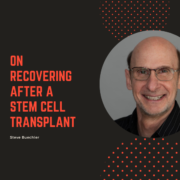Being Pro-Active in Your Care: Key AML Testing to Advocate For
Being Pro-Active in Your Care: Key AML Testing to Advocate For from Patient Empowerment Network on Vimeo.
AML specialist Dr. Naval Daver discusses essential testing for AML patients and suggests key questions that patients should ask their doctor during clinic visits.
Dr. Naval Daver is an Associate Professor in the Department of Leukemia at The University of Texas MD Anderson Cancer Center. More about Dr. Daver here.
Related Resources:

|

New AML Therapies vs Traditional Chemotherapy: What’s the Difference? |

|
Transcript:
Katherine:
Well, let’s talk about patient advocacy. What are some of the key tests that patients should ask for after they’ve been diagnosed?
Dr. Daver:
The key things that patients should want to get the information is: 1) Knowing the bone marrow blasts.
I mean, that’s really basic. Just knowing what leukemia it is. What are the blast percentage? 2) Is, I think, chromosome analysis is very critical to get that information and to make sure we’re not missing acute promyelocytic leukemia, or core-binding factor leukemia, which have different treatments and very favorable outcomes, and would never, in general, never require a allogenic transplant. At least in majority of cases.
And 3), which is the one where we still see that it may sometimes not be available or be missed, is molecular testing.
I think it’s very critical to request molecular testing. And among molecular testing, especially FLT3, maybe IDH1 and IDH2, and TP53.
So, I think these are the most important data sets. Cytogenetics, key molecular mutations, bone marrow blasts, and confirmation of the type of leukemia before we embark on any treatment.
Katherine:
How can patients feel confident, do you think, in speaking up, and becoming a partner in their care?
Dr. Daver:
When you go for the clinic visits, just to have a list of your questions written down and having them prepared and prioritizing them. I always say, have your top-three questions ready.
We’ll try to do the others. But we’ll do the top three. And I think, when you have a new diagnosis of AML, the top three should be: what is the type of leukemia I have, and what are the bone marrow blasts? Number one. Do we have any chromosome and molecular information? Number two. And number three: Are there any specific treatments for my specific AML based on that chromosome molecular information? Or do we need additional information, and can we wait for that safely? I think these are the three very reasonable questions which, I think again, most leukemia experts will automatically be discussing this.
But, I think, for a patient, I think that’s important information to make sure they get before proceeding. If there’s time, the fourth question will be: Is – Are – Do we have a choice between high intensity, low intensity? And if we do, what are the pros and cons? In some cases, there may be a choice. In some cases, it may very clear that high intensity is the way to go, or low intensity is the way to go. But still, I think it’s often good to discuss that with your physician.









